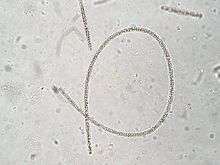Planktothrix
| Planktothrix | |
|---|---|
 | |
| Planktothrix rubescens | |
| Scientific classification | |
| Domain: | Bacteria |
| Kingdom: | Eubacteria |
| Phylum: | Cyanobacteria |
| Class: | Cyanobacteria |
| Order: | Oscillatoriales |
| Family: | Phormidiaceae |
| Genus: | Planktothrix Anagnostidis & Komárek, 1988 |
Planktothrix is a genus of filamentous cyanobacteria (often called blue-green algae). P. agardhii is regarded as a type species of the genus.[1] Like all the Oscillatoriales, Planktothrix species have no heterocyst and no akinetes, but are unique because they are planktonic, solitary trichome and have gas vacuoles.[2] Before the work of Suda et al.,[3] some species of the taxon were grouped within the genus Oscillatoria. A tremendous body of work on Planktothrix ecology and physiology has been done by Anthony E. Walsby, and the 55.6 kb microcystin synthetase gene have been sequenced.[4]
P. agardhii and P. rubescens are commonly observed in lakes of the Northern Hemisphere where they are known producers of potent hepatotoxins called microcystins.[5]
Characteristics
Like most Oscillatoriales, Planktothrix grows by cell division in a single plane to form long unbranched trichomes (also called filaments) of length up to 4 mm, but unlike other Oscillatoriales, these trichomes are phototactic and slightly motile. Typically, Planktothrix filaments do not have specialized cells such as akinetes or heterocysts, and do not produce mucilaginous envelopes, except for some rare species but only under stress conditions.[1] Several species possess constant ratio of their two main photosynthetic pigments, i.e., phycocyanins and phycoerythrins.[1] The production of cyanotoxins is facultative,[1] and strains that do not produce microcystins are commonly found in nature.[6] Apart from microcystins, they can to produce several other cyclic peptides, such as oscillapeptin J.[7]
Ecology
Both P. agardhii and P. rubescens form massive blooms in fresh water lakes and reservoirs. The green-pigmented species P. agardhii only possess phycocyanins, which gives its color. The species is commonly found at most latitudes in shallow and turbid lakes, where it can tolerate continuous mixing of the water column.[8]
The red-pigmented species P. rubescens is regularly found in clear, deep alpine and pre-alpine lakes that are seasonally stratified.[6] Outbreaks of P. rubescens are known as the "Burgundy-blood phenomenon."[9] It grows at depth, in the low light conditions of the metalimnion, where it can maximize the absorption of green light with its phycoerythrin pigments.[10] Under the action of wind-induced internal waves, P. rubescens can be moved vertically by several meters following the movements of the metalimnion, which in turn modifies rapidly (within a day) the light conditions experienced by the filaments.[11] This was shown to significantly affects the photosynthesis rate and oxygen production in a lake,[11][12] especially in lakes where the dominant organism of the phytoplankton community is P. rubescens, such as in Lake Zurich.[13]
Species
- Planktothrix agardhii (Gomont) Anagnostidis et Komárek 1988
- Planktothrix rubescens (de Candolle ex Gomont) Anagnostidis et Komárek 1988
- Planktothrix isothrix (Skuja) Komárek et Komárková 2004
See also
References
- 1 2 3 4 Komárek J, Komárková J (2004) Taxonomic review of the cyanoprokaryotic genera Planktothrix and Planktothricoides. Czech Phycology 4:1–18
- ↑ Komarek J (2003) Planktic oscillatorialean cyanoprokaryotes (short review according to combined phenotype and molecular aspects). Hydrobiologia 502:367–382
- ↑ Taxonomic revision of water-bloom-forming species of oscillatorioid cyanobacteria. Shoichiro Suda, Makoto M. Watanabe, Shigeto Otsuka, Aparat Mahakahant, Wichien Yongmanitchai, Napavarn Nopartnaraporn, Yongding Liu and John G. Day. International Journal of Systematic and Evolutionary Microbiology (2002), 52, 1577–1595 doi:10.1099/ijs.0.01834-0
- ↑ Christiansen G, Fastner J, Erhard M, Börner T, Dittmann E (2003) Microcystin biosynthesis in Planktothrix: genes, evolution, and manipulation. J Bacteriol 185:564–572 doi:10.1128/JB.185.2.564-572.2003
- ↑ Sivonen, K., and G. Jones. 1999. Cyanobacterial toxins, p. 41–111. In: I. Chorus and J. Bertram (ed.), Toxic cyanobacteria in water: a guide to public health significance, monitoring and management. E&FN Spon, London
- 1 2 Ostermaier V, Kurmayer R (2009) Distribution and abundance of nontoxic mutants of cyanobacteria in lakes of the Alps. Microbial Ecology 58:1–11 doi:10.1007/s00248-009-9484-1
- ↑ Blom JF, Bister B, Bischoff D, Nicholson G, Jung G, Süssmuth RD, Jüttner F (2003) Oscillapeptin J, a new grazer toxin of the freshwater cyanobacterium Planktothrix rubescens. J Nat Prod 66:431–434
- ↑ Reynolds CS, Huszar V, Kruk C, Naselli-Flores L, Melo S (2002) Towards a functional classification of the freshwater phytoplankton. Journal of Plankton Research 24:417–428 doi:10.1093/plankt/24.5.417
- ↑ Walsby AE; Schanz F; Schmid M (2005). "The Burgundy-blood phenomenon: A model of buoyancy change explains autumnal waterblooms by Planktothrix rubescens in Lake Zürich". New Phytologist. 169 (1): 1469–8137. doi:10.1111/j.1469-8137.2005.01567.x.
- ↑ Davis PA, Walsby AE (2002) Comparison of measured growth rates with those calculated from rates of photosynthesis in Planktothrix spp. isolated from Blelham Tarn, English Lake District. New Phytologist 156:225–239
- 1 2 Garneau M-È, Posch T, Hitz G, Pomerleau F, Pradalier C, Siegwart RY, Pernthaler J (2013) Short-term displacement of Planktothrix rubescens (cyanobacteria) in a pre-alpine lake observed using an autonomous sampling platform. Limnol Oceanogr 58:1892–1906.
- ↑ Cuypers Y, Vinçon-Leite B, Groleau A, Tassin B, Humbert J-FF (2010) Impact of internal waves on the spatial distribution of Planktothrix rubescens (cyanobacteria) in an alpine lake. ISME J 18:1–10 doi:10.1038/ismej.2010.154
- ↑ Van den Wyngaert S, Salcher MM, Pernthaler J, Zeder M, Posch T (2011) Quantitative dominance of seasonally persistent filamentous cyanobacteria Planktothrix rubescens in the microbial assemblages of a temperate lake. Limnology and Oceanography 56:97-109. doi:10.4319/lo.2011.56.1.0097